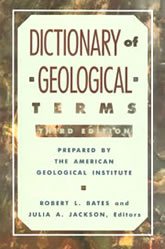Geological Terms Beginning With "E"
For terms beginning with other letters, please click below
|
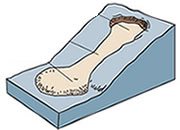
Earthflow
A type of landslide or mass wasting. A downslope movement of soil and rock debris that is confined to a well-defined "chute" and spreads out over the run-out area in the form of a lobe. The material is mostly fine-grained and moves as a "flow" instead of as a rotating mass. Most earthflows are have a very high moisture content but dry flows are also possible.

Earthquake
A trembling of the earth caused by a sudden release of energy stored in subsurface rock units. This release of energy usually occurs when the subsurface rock units break to form a fault or when movement on an existing fault occurs.
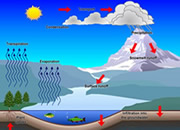
Earth Science
Earth Science is the study of the Earth and its neighbors in space. It includes the study of solar system astronomy, geology, oceanography and meteorology. Some people assume that "geology" and "earth science" are identical, but that is not true. "Geology" is a much more limited science and just one part of "earth science."
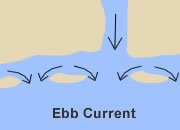
Ebb Current
A tidal current that moves towards the ocean after high tide has peaked, draining the inter-tidal zone. These currents can be very strong at the openings of bays and between barrier islands, where large amounts of water must flow through a narrow opening in a limited amount of time. The arrows in the image show the directions that water would flow as ebb currents cause a river to accelerate and the lowering of sea level drains lagoons behind barrier islands.

Effluent Stream
A stream that gains water from groundwater flow. These streams are typical of humid climates where water tables are high. The discharge of an effluent stream can be sustained by groundwater flow for long periods of time between runoff-producing rainfall or snowmelt. Effluent streams generally increase in discharge downstream and contain water throughout the year. The opposite is an influent stream.
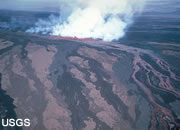
Effusive Eruption
An eruption that is dominated by an outpouring of lava rather than an explosive ejection of material through the air. Most effusive eruptions produce basaltic lavas. The photo shows lava flows streaming from the eruption of Mauna Loa Volcano in Hawaii in 1984.
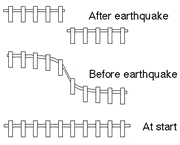
Elastic Limit
The maximum stress that can be applied to a body without resulting in permanent deformation - the rock reverts to its original shape after the stress is removed. In the case of a fault or a fold, the elastic limit is exceeded and the deformation becomes a permanent structure of the rock.

Elastic Rebound Theory
A theory that explains the earthquake process. In this theory, slowly accumulating elastic strain builds within a rock mass over an extended period of time. When the rock fails this strain is suddenly released through fault movement, producing an earthquake. In the bottom image the undeformed fenceline at the bottom is before strain accumulation begins. The middle image shows the buildup of strain in the Earth under the fence line. This is plastic deformation. When the Earth (and fence) rupture, the elastic limit was exceeded.
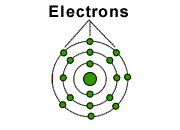
Electron
A subatomic particle with a negative charge and negligible mass that orbits the nucleus of an atom.

Elevation
The vertical distance between mean sea level and a point or object on, above or below Earth's surface. In the image of a topographic map, the brown lines that represent elevations above sea level.

Emerald
Emerald is the gemstone name of the mineral beryl when it has a rich green color. It is the most popular gem of the beryl mineral group. Most emeralds have abundant inclusions and fractures. If the color is green, but not a rich green, the gem is called "green beryl." The term "emerald" is reserved for stones of excellent green color.

Eolian
A term used in reference to the wind. Eolian materials and structures are created, moved and deposited by the wind. Sand is an eolian material and a sand dune is an eolian structure.
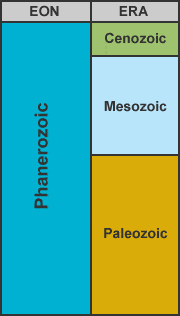
Eon
The major divisions of the geologic time scale. Eons are divided into intervals known as "eras." Two eons of the geologic time scale are the Phanerozoic (570 million years ago to present) and the Cryptozoic (4,600 million years ago until 570 million years ago). The Phanerozoic is divided into three eras, Cenozoic, Mesozoic and Paleozoic.
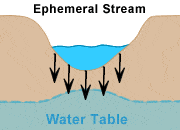
Ephemeral Stream
A stream that flows for a short interval of time after precipitation or snow melt in the immediate area. Ephemeral streams carry runoff water. Their channels are above the water table and they normally receive no contribution from groundwater.
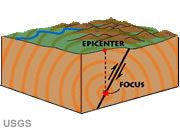
Epicenter
The point on the Earth's surface directly above the focus of an earthquake. It is often - but not always - the location where the strength of the earthquake's shaking is most intensely felt.
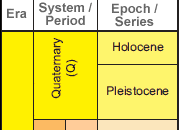
Epoch
A subdivision of geologic time that is longer than an age but shorter than a period. The Quaternary Period is divided into two epochs, the Pleistocene and the Holocene.
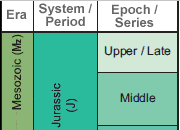
Era
A subdivision of geologic time that is longer than a period but shorter than an eon. Precambrian, Paleozoic, Mesozoic, and Cenozoic are the eras of the time scale from oldest to youngest.

Erosion
A general term applied to the wearing away and movement of earth materials by gravity, wind, water and ice. The image shows a dramatic example of coastal erosion along Alaska's Arctic Ocean shoreline.
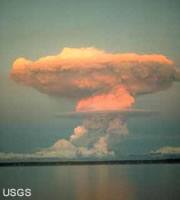
Eruption Cloud
A cloud of tephra and volcanic gas that have been erupted by a volcano. The eruption cloud in the photo was produced by Alaska's Redoubt Volcano in April of 1980.
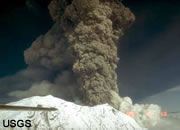
Eruption Column
A towering, rapidly rising cloud of tephra and volcanic gas escaping the vent of a volcano immediately after an explosive eruption. Differs from an eruption cloud because the material is being propelled upwards by the force of the blast and not being held aloft by rising heat. The image shows the eruption cloud from the Crater Peak vent of Mount Spurr Volcano in Alaska on August 18, 1992.
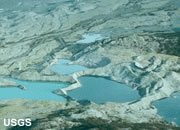
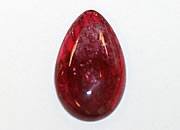
Eudialyte
Eudialyte is a rare mineral found in igneous rocks. It serves as a minor ore of zirconium and as a minor gem mineral. It occurs in yellow, brown and bluish crystals - but bright red specimens are favored as a collector's gem.
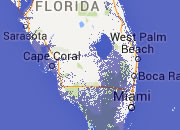
Eustatic Sea Level Change
A rise or fall in sea level that affects the entire Earth. Thought to be caused by an increase/decrease in the amount of available water or a change in the capacity of ocean basins. At the present time, glacial and polar melting is causing a slow but steady sea level rise which is having an impact on coastal communities.
|
Dictionary of Geological Terms - Only $19.99 All scientific disciplines have an essential vocabulary that students and professionals must understand to learn and communicate effectively. A geology dictionary that is used regularly is one of the most important tools for developing professional competence. A good dictionary should be on the desk of every geologist and within easy reach. This dictionary is compact and inexpensive at only $19.99. More information. |
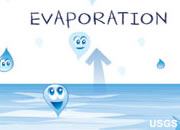
Evaporation
The process of liquid water becoming water vapor. Includes vaporization from water surfaces, land surfaces and snow/ice surfaces.
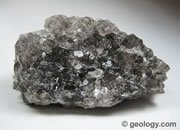
Evaporite
A chemical sediment or sedimentary rock that has formed by precipitation from evaporating waters. Gypsum, salt, nitrates and borates are examples of evaporite minerals.

Evapotranspiration
All methods of water moving from a liquid to water vapor in nature. Includes both evaporation and transpiration.
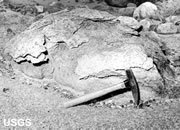
Exfoliation
A physical weathering process in which concentric layers of rock are removed from an outcrop.
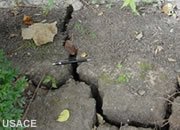
Expansive Clay (Expansive Soil)
A clay or a clay soil that expands when water is added and contracts when it dries out. This volume change can cause severe damage when it occurs under or adjacent to buildings, roadways, or underground utilities.
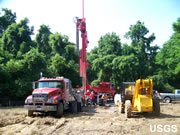
Exploration
The work of identifying areas that may contain viable mineral, groundwater or fossil fuel resources. This work can include surface mapping, remote sensing, exploratory drilling, geophysical testing, geochemical testing and other activities. The photo shows drilling into the Potomac Formation to locate sand layers suitable for groundwater flow.

Exploratory Drilling
Drilling done to locate mineral deposits in an area where little subsurface data about those minerals is available. Exploratory wells may not have the ability to produce the minerals if they are discovered. The photo shows drilling into the Potomac Formation to locate sand layers suitable for groundwater flow.


Extrusive
Igneous rocks that are erupted from a volcano and crystallize at Earth's surface. Basalt is the most common.
|
| More General Geology |
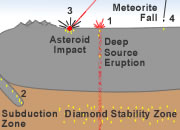 |
Diamonds from Coal? |
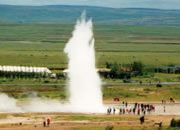 |
What is a Geyser? |
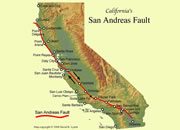 |
What is the San Andreas Fault? |
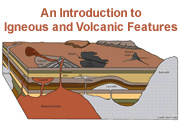 |
Igneous and Volcanic Features |
 |
The Doorway to Hell |
 |
Topo Maps |
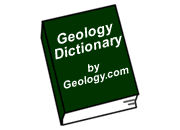 |
Geology Dictionary |
 |
Gifts That Rock |

Find Other Topics on Geology.com:

|

| ||

|

| ||

|

| ||

|

|

